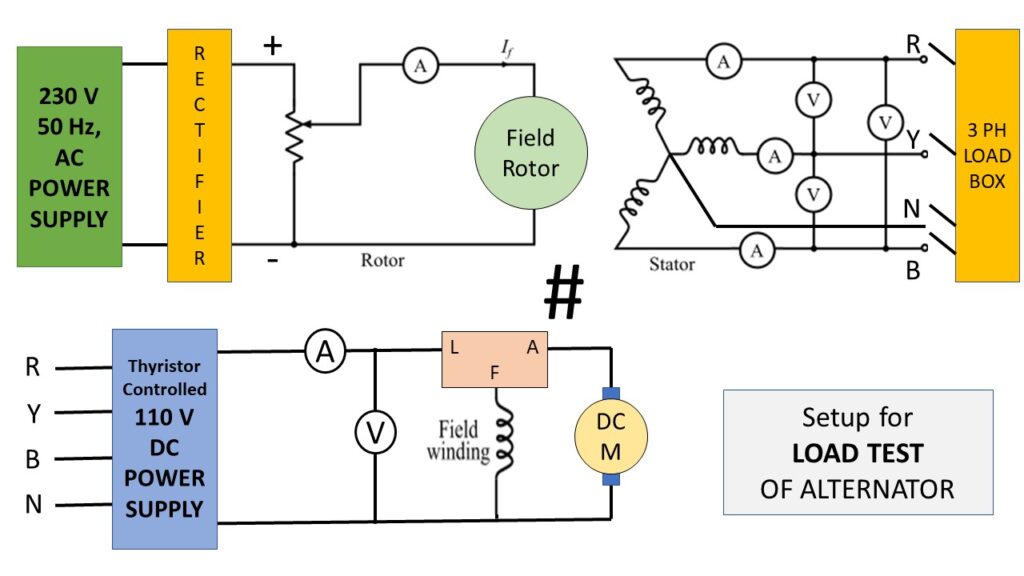Experiment No. : 8
Experiment Name:
Perform the direct loading test on the given three phase alternator and determine the regulation and efficiency.
Objective:
- To perform the direct loading test on the given three phase alternator.
- To determine the regulation and efficiency.
Theory:
The voltage regulation of a synchronous generator [Alternator] can be determined by various methods. In case of small capacity alternators, direct loading test used to determine regulation, while in case of large capacity Alternators Synchronous Impedance method is used.
The below diagram shown is three phase alternator on which Direct Loading test is conducted.A three phase load is connected to star connected armature with the help of TPSTN [Triple Pole Single Throw with Neutral] switch. By using an external D.C supply, the field winding is excited.A rheostat is connected in series with the field winding, to control the flux i.e. current in the field winding.In the below figure, the prime mover shown is used to drive the alternator at Synchronous speed.
Direct Loading method Procedure:
By using prime mover, the alternator is driven at Synchronous speed [Ns].
Now Eph is proportional to Φ After giving the D.C supply to the field winding, the field current is adjusted in order to adjust flux so that rated voltage appears across the terminals.This is observed on a voltmeter connected across the terminals. Next load is connected by using the TPSTN switch.The load is increased in steps so that ammeter reads rated current.This is the full condition of the alternator. Again adjust the voltage to its rated value by field excitation using the rheostat.
Then disconnect the entire load by opening TPST switch, keeping the speed and field excitation constant.As load is disconnected there will be no armature current and associated drops.Now the voltmeter shows a reading which is the actual value of internally induced e.m.f called no load terminal voltage.Next convert both the readings into phase values.The voltage on full load is Vph and voltage when load is thrown off is Eph. So voltage regulation of alternator or synchronous generator can be determined by using the formula
% Reg = (Ea – V) / V x 100
The value of regulation of alternator or synchronous generator obtained by this Direct loading method is accurate because a particular load at required power factor is actually connected to note down the readings.
Circuit Diagram for Direct Load Test :

Observation Table:
| Sl. No. | Input Voltage to the DC Shunt Motor (Vin) (V) | Input Current to the DC Shunt Motor (Iin)(A) | Input Power (Vin×Iin) (W) | Input Field Current to Alternator (If) (A) | Output Voltage per phase at full load (V) | Load Current at full load (A) | Load pf (cos Φ) | Output Power (√3 Vout×Iout×cos Φ) (W) | Efficiency (η) |
| 1. | 108 | 4.1 | 442.8 | 1.9 | 72.22 | 1.31 | unity | 163.86 | 37.00 % |
When the load is disconnected by opening the TPST switch,
| Sl. No. | Field Current (A) | Open circuit voltage (V) |
| 1. | 1.9 | 131.0 |
Calculation:
Load Voltage observed (V)= 72.22 V
Percentage voltage regulation = (Ea−V)/V×100% = (131.0-72.22)/72.22×100% = 81.39 %
Efficiency, η = Output power (Pout) / Input Power (Pin) ×100% = 163.86/442.8×100% = 37.00%
Apparatus Used:
| Sl. No. | Name of the Apparatus | Specification | Quantity | Maker’s Name |
| 1. | Alternator | 3-ph, 1500 rpm, 3 kVA, 12.6A, 110V, Field Current: 2A | 1 | Tech-Track |
| 2. | DC Motor | 5HP, 1500 rpm, Shunt Wound, 110V, 40A, Field Current: 2A | 1 | Tech-Track |
| 3. | Thyristor Controlled DC Power Supply | Input: 3-ph, 440V AC Output: 220V, 50A DC | 1 | Sushama Electronics |
| 4. | Tachometer | Digital, Non-contact type, 2.5-99999 rpm | 1 | Metrix+ |
| 5. | Clip-on Ammeter | 0-1000A AC | 1 | Metravi |
| 6. | Digital Multimeter | 0-750V, 0-10A AC | 1 | Akademika |
| 7. | Resistive Load Box | 15A, 220 V | 1 | Tech-Track |
Remarks: Performing all test we have find out the regulation and efficiency of the alternator. Due to accuracy of the measuring instruments and fast observation the data, the result is not so accurate. Ignoring this, the test is performed successfully.
